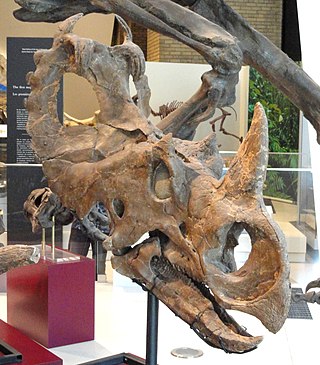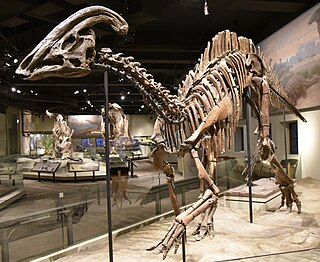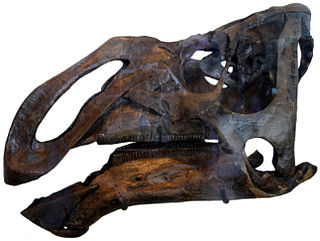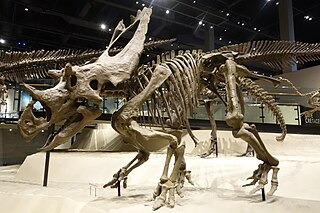This article relies largely or entirely on a single source .(August 2015) |
The Judithian was a North American faunal stage lasting from 83.5 to 70.6 million years ago. It overlaps with the Campanian global stage.
This article relies largely or entirely on a single source .(August 2015) |
The Judithian was a North American faunal stage lasting from 83.5 to 70.6 million years ago. It overlaps with the Campanian global stage.
Dinosaur faunas of the Judithian age may represent the peak of dinosaur evolution in North America. [1] Hadrosaurs were universally the dominant herbivore of the period and comprised more than half of "a typical assemblage." [1] This was also the period of greatest genetic diversity among large herbivorous dinosaurs. [1] Just in Montana and Southern Alberta were ten genera of ceratopsians and ten genera of hadrosaurs. [1]
Thomas M. Lehman has observed that Corythosaurus and Centrosaurus haven't been discovered outside of southern Alberta even though they are the most abundant Judithian dinosaurs in the region. [2] Large herbivores like the ceratopsians and hadrosaurs living in North America during the Late Cretaceous had "remarkably small geographic ranges" despite their large body size and high mobility. [2] This restricted distribution strongly contrasts with modern mammalian faunas whose large herbivores' ranges "typical[ly] ... span much of a continent." [2] Another example is Pentaceratops , the only known Judithian ceratopsian from New Mexico. [2] Only the rarer species among modern mammal communities would be able to distinguish different latitudinal zones, and some of these taxa are likely too rare to fossilize. [3] This lack of provinciality exists despite the strong temperature gradient. [3] Restrictions in herbivorous dinosaur distribution may be due to foliage preferences, narrow tolerance for variation in climate or other environmental factors. [3] The restrictions on herbivorous dinosaur distribution must have been due to ecological factors rather than physical barriers because carnivorous dinosaurs tended to have wider distributions, especially smaller forms. [3]
As of his 2001 paper, restrictions in dinosaur occurrences based on distance from the paleo-shoreline had already been well documented. [4] Vaguely distinguished inland-versus-coastal dinosaurs had been discussed previously in the scientific literature. [4] Terrestrial sedimentary strata from the Judithian to the Lancian are generally regressive throughout the entire sequence the preserved changes in fossil communities represent not only phylogenetic changes but ecological zones from the submontane habitats to near-sea level coastal habitats. [5] Modern life at high elevations in lower latitudes resembles life at low elevation in higher latitudes. [6] There may be parallels to this phenomenon in Cretaceous ecosystems, for instance, Pachyrhinosaurus is found in both Alaska and upland environments in southern Alberta. [6] Northern and Southern animal biomes approximately correspond respectively with the Aquillapollenites and Normapolles palynofloral provinces. [6]
An association between Centrosaurus and Corythosaurus is characteristic of southern Alberta. [1] Earlier research had found that lambeosaurines are less common in contemporary Montanan strata and with different centrosaurs as Monoclonius takes the place of Centrosaurus. [1] Inland environments also differed, with the contemporary Two Medicine Formation preserving an inland fauna characterized by Maiasaura and the early pachyrhinosaur Einiosaurus . [1] Farther south was characterized by lower taxonomic diversity in communities where lambeosaurines were less common and centrosaurs were completely lacking. [1] There Kritosaurus , Parasaurolophus, and Pentaceratops are the dominant fauna. [1] The giant eusuchian Deinosuchus is also "conspicuous" in the southern biome. [1] Farther south, in Texas, Kritosaurus predominates. The biomes of the Eastern US may have resembled those of Texas except completely lacking in ceratopsians. [1] Parasaurolophus and Kritosaurus are also present in northern latitudes, so evidently exchange between them occurred, but both are uncommon outside of the southern biome. [1]

Trachodon is a dubious genus of hadrosaurid dinosaur based on teeth from the Campanian-age Upper Cretaceous Judith River Formation of Montana, U.S. It is a historically important genus with a convoluted taxonomy that has been all but abandoned by modern dinosaur paleontologists.

Hadrosaurids, or duck-billed dinosaurs, are members of the ornithischian family Hadrosauridae. This group is known as the duck-billed dinosaurs for the flat duck-bill appearance of the bones in their snouts. The ornithopod family, which includes genera such as Edmontosaurus and Parasaurolophus, was a common group of herbivores during the Late Cretaceous Period. Hadrosaurids are descendants of the Late Jurassic/Early Cretaceous iguanodontian dinosaurs and had a similar body layout. Hadrosaurs were among the most dominant herbivores during the Late Cretaceous in Asia and North America, and during the close of the Cretaceous several lineages dispersed into Europe, Africa, and South America.

Corythosaurus is a genus of hadrosaurid "duck-billed" dinosaur from the Late Cretaceous period, about 77–75.7 million years ago, in what is now western North America. Its name is derived from the Greek word κόρυς, meaning "helmet", named and described in 1914 by Barnum Brown. Corythosaurus is now thought to be a lambeosaurine, thus related to Lambeosaurus, Nipponosaurus, Velafrons, Hypacrosaurus, and Olorotitan. Corythosaurus has an estimated length of 7.7–9 metres (25–30 ft) and has a skull, including the crest, that is 70.8 centimetres tall.

Pentaceratops is a genus of herbivorous ceratopsid dinosaur from the late Cretaceous Period of what is now North America. Fossils of this animal were first discovered in 1921, but the genus was named in 1923 when its type species, Pentaceratops sternbergii, was described. Pentaceratops lived around 76–73 million years ago, its remains having been mostly found in the Kirtland Formation in the San Juan Basin in New Mexico. About a dozen skulls and skeletons have been uncovered, so anatomical understanding of Pentaceratops is fairly complete. One exceptionally large specimen later became its own genus, Titanoceratops, due to its more derived morphology, similarities to Triceratops, and lack of unique characteristics shared with Pentaceratops.

Centrosaurus is a genus of centrosaurine ceratopsian dinosaur from Campanian age of Late Cretaceous Canada. Their remains have been found in the Dinosaur Park Formation, dating from 76.5 to 75.5 million years ago.

Parasaurolophus is a genus of hadrosaurid "duck-billed" dinosaur that lived in what is now western North America and possibly Asia during the Late Cretaceous period, about 76.9–73.5 million years ago. It was a large herbivore that could reach over 9 metres (30 ft) long and weigh over 5 metric tons, and were able to move as a biped and a quadruped. Three species are universally recognized: P. walkeri, P. tubicen, and the short-crested P. cyrtocristatus. Additionally, a fourth species, P. jiayinensis, has been proposed, although it is more commonly placed in the separate genus Charonosaurus. Remains are known from Alberta, New Mexico, and Utah, as well as possibly Heilongjiang if Charonosaurus is in fact part of the genus. The genus was first described in 1922 by William Parks from a skull and partial skeleton found in Alberta.

Lambeosaurus is a genus of hadrosaurid dinosaur that lived about 75 million years ago, in the Late Cretaceous period of North America. This bipedal/quadrupedal, herbivorous dinosaur is known for its distinctive hollow cranial crest, which in the best-known species resembled a mitten. Several possible species have been named, from Canada, the United States, and Mexico, but only the two Canadian species are currently recognized as valid.

Gryposaurus was a genus of duckbilled dinosaur that lived about 80 to 75 million years ago, in the Late Cretaceous of North America. Named species of Gryposaurus are known from the Dinosaur Park Formation in Alberta, Canada, and two formations in the United States: the Lower Two Medicine Formation in Montana and the Kaiparowits Formation of Utah. A possible additional species from the Javelina Formation in Texas may extend the temporal range of the genus to 66 million years ago.

Kritosaurus is an incompletely known genus of hadrosaurid (duck-billed) dinosaur. It lived about 74.5-66 million years ago, in the Late Cretaceous of North America. The name means "separated lizard", but is often mistranslated as "noble lizard" in reference to the presumed "Roman nose".

Olorotitan was a monotypic genus of lambeosaurine duck-billed dinosaur, containing a single species, Olorotitan arharensis. It was among the last surviving non-avian dinosaurs to go extinct during the Cretaceous–Paleogene extinction event, having lived from the middle to late Maastrichtian-age of the Late Cretaceous era. The remains were found in the Udurchukan Formation beds of Kundur, Arkharinsky District, Amur Oblast, Eastern Russia, in the vicinity of the Amur River.

Prosaurolophus is a genus of hadrosaurid dinosaur from the Late Cretaceous of North America. It is known from the remains of at least 25 individuals belonging to two species, including skulls and skeletons, but it remains obscure. Its fossils have been found in the late Campanian-age Upper Cretaceous Dinosaur Park Formation in Alberta, and the roughly contemporaneous Two Medicine Formation in Montana, dating to around 75.5-74.0 million years ago. Its most recognizable feature is a small solid crest formed by the nasal bones, sticking up in front of the eyes.

Lambeosaurinae is a group of crested hadrosaurid dinosaurs.
The Edmontonian was a North American faunal epoch occurring during the Late Cretaceous, lasting from approximately 70 to 68 million years ago.

Velafrons is a genus of lambeosaurine hadrosaurid dinosaur from the Late Cretaceous of Mexico. It is known from a mostly complete skull and partial skeleton of a juvenile individual, with a bony crest on the forehead. Its fossils were found in the late Campanian-age Cerro del Pueblo Formation, near Rincon Colorado, Coahuila, Mexico. The type specimen is CPC-59, and the type species is V. coahuilensis.

The Aguja Formation is a geological formation in North America, exposed in Texas, United States and Chihuahua and Coahuila in Mexico, whose strata date back to the Late Cretaceous. Dinosaur remains are among the fossils that have been recovered from the formation. Fossil palms have also been unearthed here.

Utahceratops is an extinct genus of ceratopsian dinosaur that lived approximately 76.4~75.5 million years ago during the Late Cretaceous period in what is now Utah. Utahceratops was a large-sized, robustly-built, ground-dwelling, quadrupedal herbivore, that could grow up to an estimated 4.5–5 m (15–16 ft) long.

Titanoceratops is a controversial genus of herbivorous ceratopsian dinosaur. It was a giant chasmosaurine ceratopsian that lived in the Late Cretaceous period in what is now New Mexico. Titanoceratops was named for its large size, being one of the largest known horned dinosaurs and the type species was named T. ouranos, after Uranus (Ouranos), the father of the Greek titans. It was named in 2011 by Nicholas R. Longrich for a specimen previously referred to Pentaceratops. Longrich believed that unique features found in the skull reveal it to have been a close relative of Triceratops, classified within the subgroup Triceratopsini. However, other researchers have expressed skepticism, and believe "Titanoceratops" to simply be an unusually large, old specimen of Pentaceratops.
Dinosaur paleobiogeography is the study of dinosaur geographic distribution, based on evidence in the fossil record.
The Lancian was a North American faunal stage of the Late Cretaceous. It was the final stage of the Cretaceous period in North America, lasting from approximately 70.6 to 66 million years ago.

This timeline of hadrosaur research is a chronological listing of events in the history of paleontology focused on the hadrosauroids, a group of herbivorous ornithopod dinosaurs popularly known as the duck-billed dinosaurs. Scientific research on hadrosaurs began in the 1850s, when Joseph Leidy described the genera Thespesius and Trachodon based on scrappy fossils discovered in the western United States. Just two years later he published a description of the much better-preserved remains of an animal from New Jersey that he named Hadrosaurus.